1. Wat Phrathat Doi Suthep
The one temple every first-time visitor absolutely, positively must see is the mountain-top Wat Phrathat Doi Suthep. The temple is a "must see" not only for its importance as a pilgrimage temple, but also for the outstanding views it affords of the city and its surrounding plain, when the weather cooperates. A trip to the temple is usually combined with a stop at the royal Phu Phing Palace and the Doi Pui Maeo village.
The temple of Wat Phra That Doi Suthep is certainly one of the most important temples in Chiang Mai, as well as one of the most revered among all Thais. The temple is a major pilgrimage destinations during the important Buddhist holidays of Makha Buja and Visak. Its importance, as well as its location, owes much to the legend of its founding.
According to this legend, a Buddha relic, which some say glowed, magically replicated just before it was about to be enshrined in the big chedi at Wat Suan Dok. The "cloned" relic was placed on the back of a sacred white elephant, which was allowed to roam where-ever it wanted.
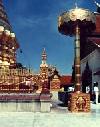 More details from around 1989. |
The elephant eventually climbed to the top of Suthep Mountain, trumpeted three times, turned around three times, knelt down and died. This was taken as a sign that this was the spot where the relic wanted to be, so King Ku Na built the original of the chedi on Doi Suthep at the end of 14th century.
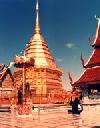 The chedi and courtyard after its first big renovation in 1992. |
The temple grew and changed in the 600 years since its founding. In particular, it was extensively renovated in the economic "boom" years of the early 1990's. From our admittedly western viewpoint, a lot of the charm has been lost as everything was covered in granite and gold. However, the temple remains an important sight that first-time visitors to Chiang Mai shouldn't miss.
The chedi sits in a rather small courtyard at the very peak of the mountain. The courtyard building sits on a larger plaza containing several buildings as well as a lookout point from which you can see, weather permitting, all of Chiang Mai and the surrounding plain.
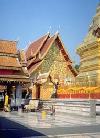 The chedi in 1999. |
Among the buildings on the plaza is a small museum displaying old pieces of temple wares as well as some of the more ancient or unique monetary donations to the temple. Note that before entering the courtyard containing the chedi, you must remove your shoes. You must also be dressed appropriately, although the temple can provide some clothing on loan to cover up your naughty knees and slinky shoulders.
Now for the bad news: To reach the temple itself requires a climb up a naga staircase of 309 steps. For the faint of heart, there's also a funicular cable-car to the top which has just been re-built after several fatal crashes. The fare for the new improved funicular is 20 Baht.
At the base of stairs, where cars and motorcycles park, there is a large market of food stalls, jade factories and endless relentless souvenir sellers.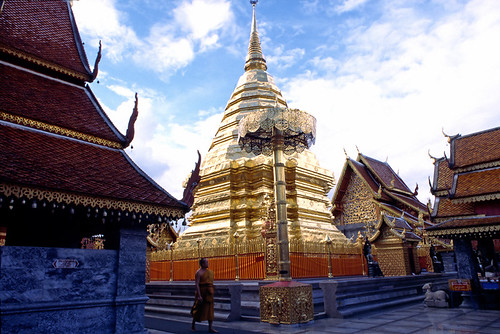


2. Wat Chedi Luang
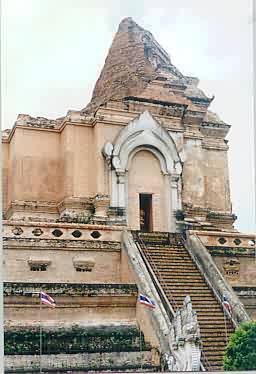
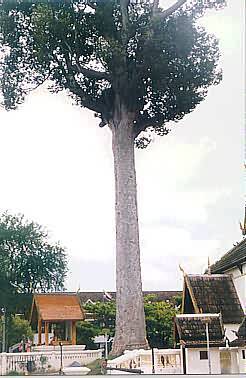 King Saen Muang Ma began building the Phra Chedi Luang to enshrine the relics of his father at the end of the 14th century, but King Tilokarat completed it. The chedi used to be 90 meters high before it was partly destroyed in an earthquake in 1545; it was to remain the tallest structure in Chiang Mai for over 500 years. The present restored chedi is about 60 meters high.
King Saen Muang Ma began building the Phra Chedi Luang to enshrine the relics of his father at the end of the 14th century, but King Tilokarat completed it. The chedi used to be 90 meters high before it was partly destroyed in an earthquake in 1545; it was to remain the tallest structure in Chiang Mai for over 500 years. The present restored chedi is about 60 meters high.
One of the best times to see this chedi is during the wian tian ceremony in the evening on one of the main Buddhist festival days.
The large viharn was built in 1928. Round columns with bell shaped bases and lotus finials support the high red ceiling inside. The standing Buddha image inside is known as the Phra Chao Attarot. Made of a combination of brass alloy and mortar, the image dates back to King Saen Muang Ma (r.1385-1401). Buddhist posters are placed along the walls between the windows, and cabinets with Buddha images and Bencharong ceramics line the walls.
The cross shaped hall to the south of the main viharn contains the city pillar. Statues in small shelters surrounding this building are homes of guardian spirits. Legends say that a hermit (whose image is in a shelter on the west side of the building) went to the God Indra to ask for protection for the city from enemies. On condition that appropriate offerings were made, Indra permitted two kumaphan (mythical human-beast creature) to carry the Inthakhin pillar from the Tavatimsa heaven to the city.
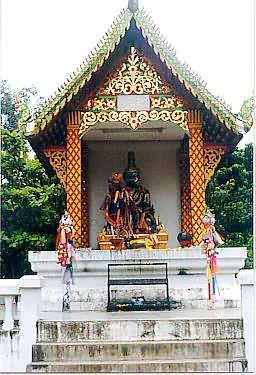 Chao Kawila moved the city pillar to its present site from Wat Sadoe Muang in 1800. He built statues of the kumaphan under shelters to the north and south of the main entrance to the temple. He also planted the three large yang (dipterocarpus alatus) trees. According to legend, the tree nearest the city pillar will protect the city as long as it is not cut down.
Chao Kawila moved the city pillar to its present site from Wat Sadoe Muang in 1800. He built statues of the kumaphan under shelters to the north and south of the main entrance to the temple. He also planted the three large yang (dipterocarpus alatus) trees. According to legend, the tree nearest the city pillar will protect the city as long as it is not cut down.
Other buildings in the compound include the Lanna campus of the Mahamakut Buddhist University (This is the northern campus for monks of the Thammayut sect, a reformist sect founded by King Mongkut (Rama IV r.1851-1881, who was dissatisfied with the established Mahanikai sect in the late 1830's). To the west of the chedi is a viharn with a reclining Buddha and the Sangkhachai Buddha. From this area an exit leads out onto Chaban Road.


3. Wat Umong
Wat Umong (or Oomong) is one of my favorite temples in Chiang Mai. It can be an especially magical place just after the rainy season has ended, around early October or November.
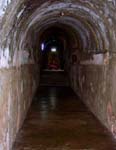 Main tunnel leading to the alter. |
Wat Umong is unique in many respects. For one, it's built in the foothills of Suthep mountain and is still heavily forested. But the most unique feature of the temple are the tunnels which give the wat its name (umong is the Thai word for "tunnel").
The temple and its tunnels were built in the late 14th century. On a level open space, a large artificial mound was built and then criss-crossed with tunnels. The legend is that the temple was built like this for a highly regarded monk who was nonetheless a little crazy. The somewhat maze-like tunnels kept the mad monk from wandering off.
The monastery was later abandoned and wasn't used again until the 1940's. The long disuse is probably what accounts for the overgrown atmosphere of the temple. That's why the temple is so great to visit right after the rains have gone. The brick walls of the mound are covered with moss and small plants. Other stone works are covered in moss and vines.
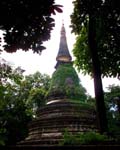 Chedi atop the artificial mound. |
Atop one end of the mound is the temple's chedi, reachable by a short stairway to the left of the tunnel entrances. The main "bell" section of the pagoda is mostly covered in thick vines, giving a strong sense of decay even though the structure of the pagoda appears sound. When I was here in early October 2002, it appeared that the chedi had been opened and the relic inside removed. A curious little ad-hoc alter had been set up on the base of the pagoda right in front of the rough opening in the brick work. The alter consisted of many tiny Buddha images as well as other offerings, apparently left by many people. By August 2007, the pagoda had been restored and most of the vines removed.
 "Buddha parts" collected from other monasteries. |
A trail leads from the chedi across the roof of the mound and down the other side. Just beyond the far edge of the mound is a rather ghastly, very emaciated seated Buddha image. This style of Buddha image was in style for a short time hundreds of years ago, but today there are very few examples of it still in existence.
The path down winds through the monk's cells and other out-buildings, then back around to the front of the mound. Just as the path turns back towards the main tunnel entrance is a curious collection of Buddha heads and other relics from various temples. This odd collection started when one of the temple's supporters rescued some broken images from an abandoned temple in a nearby province and bought them here. Now, apparently, when people run across such relics or have a broken Buddha they want to replace, they bring them here.
If you continue on the path on past the mound and the pagoda, you'll eventually come to a small lake with many fish, birds and other wildlife.



ไม่มีความคิดเห็น:
แสดงความคิดเห็น